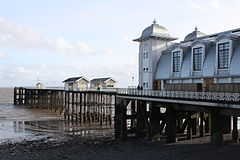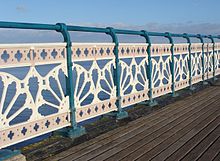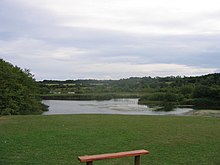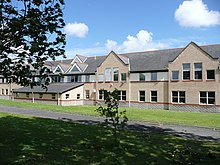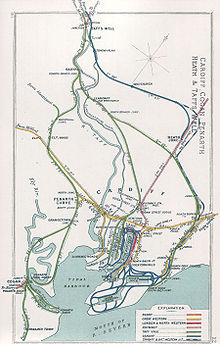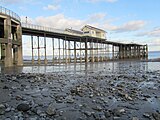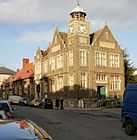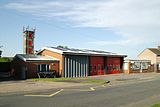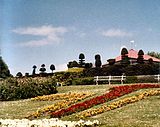Penarth (Wales)
| Penarth | ||
|---|---|---|
| Penarth Pier | ||
| Coordinates | 51 ° 26 ′ N , 3 ° 10 ′ W | |
| OS National Grid | ST185715 | |
|
|
||
| Residents | 22,083 (as of 2011) | |
| administration | ||
| Post town | PENARTH | |
| ZIP code section | CF64 | |
| prefix | 029 | |
| Part of the country | Wales | |
| Preserved County | South Glamorgan | |
| Unitary authority | Vale of Glamorgan | |
| British Parliament | Cardiff South and Penarth | |
| Welsh Parliament | Cardiff South and Penarth | |
Penarth ( pəˈnɑrθ , pɛnˈarθ ) is a town in the Vale of Glamorgan ( Welsh Bro Morgannwg ), Wales. It is about 5.2 Miles (8.4 km) southwest from the center of the Welsh capital Cardiff on the north shore of the Severn - estuary (Môr Hafren) at the south end of the Cardiff Bay area. Penarth is the wealthiest seaside resort in the Cardiff Urban Area , and the second largest city in the Vale of Glamorgan after the administrative center of Barry .
Name and coat of arms
Penarth is a Welsh place name and could be a combination of the terms: Welsh pen (head) and Welsh arth (bear) to mean head of the bear or bear head. This was the generally accepted meaning for centuries and is still reflected in the depiction of the city's coat of arms, in which bears are depicted. Linguists, however, have put forward theories that the name could also be a slipping of Welsh Pen-y-garth , where garth is the word for cliff and the place accordingly meant summit of the cliffs or cliff top. The Welsh-English dictionary Welsh Y Geiriadur Mawr (The Big Dictionary: Gomer Press) also translates penardd / penarth (feminine noun) as promontory (headland / peninsula).
The city coat of arms was drawn by the city architect in 1875 based on detailed instructions from the city council. A bear's head can be seen above a shield, which is held by two other standing bears . The shield contains a Welsh dragon ( Draig Goch ) to represent that the city is in Wales, as well as a sailing ship symbolizing Penarth's long maritime trade tradition.
population
During the Victorian Age , Penarth was a popular vacation spot advertised across the country as "The Garden by the Sea". Holidaymakers came mainly from the Midlands and the West Country (South West England and Cornwall) as well as day-trippers from the South Wales Valleys . Although the number of visitors has dropped significantly, the place is still a popular summer holiday destination, especially for seniors.
For this reason, too, the city has an extremely large number of retirees, namely more than 25 percent of the population, but now it is mainly a dormitory town for commuters to Cardiff. In 2001 the population was 20,396 (United Kingdom Census 2001).
There are extensive neighborhoods in the style of Victorian and Edwardian architecture.
history
Early history
There has been evidence of human habitation in the Penarth area for at least 5000 years. In 1956 several stone axes from the Neolithic Age were found. A large hoard from Roman times with rings and coins was unearthed in nearby Sully .
From the 12th century to 1543 the Penarth lands belonged to the canons of St Augustine in Bristol . The Norman Church of St Augustine on the headland dates from this period. After the dissolution of the monasteries in the 16th century ownership to the was Dean (Dean) and Chapter ( chapter ) of Bristol Cathedral transmitted.
The lands were leased to the Earls of Plymouth from St. Fagans Castle . The family bought the land directly in 1853.
Because the land was owned by a religious institution, there was no need to build a large country house for a family in Penarth. The oldest building in the area is therefore Cogan Pill (Baron's Court; Tudor mansion), which belonged to the Herbert (Earls of Plymouth) family, on the hill of Cogan Pill. Today there is a restaurant in the building.
Piracy was common on the Penarth coast and a special commission was set up in the 1570s to investigate and eradicate piracy. It was believed that leading families in Penarth were involved.
Penarth's medieval walled sheriff's pound was used as a repository for stray sheep, cattle and pigs, but also for thieves, cattle thieves and vagabonds until the late 18th century. It was in what is now the NatWest Bank car park on Plymouth Road.
In 1803, Penarth recorded 800–900 acres (3.6 km²) of farmland with multiple farms. According to the 1801 census, only 72 people lived in the manor . Until 1851 Penarth was little more than a small rural farming and fishing village with 24 houses and 105 inhabitants and one of five parishes within the Hundred von Dinas Powys , with a total population of just under 300 inhabitants. Before the pier and dock were built, there was only a small fleet of sailing fishing boats moored in front of the town center.
The owner of Plymouth Estate , Harriet Windsor-Clive, 13. Baroness Windsor , took care of the planning, the construction and development of the new city, where she offered 99-year leases and remained landowner. All of the residents of Penarth were then tenants of Plymouth Estates and paid an annual rent. It was not until the Leasehold Reform Act 1967 that residents were given the opportunity to acquire their land ( freehold ) or to obtain lease extensions to 999 years.
The first houses to be built in the city were streets of terraced houses with corner shops and pubs on almost every corner. The streets followed the contour lines of the headland and developed in the fast growing Cogan Area near the dock. Local gray limestone, which was mined in the area of today's Cwrt-y-vil Playing Field , gave the city's older buildings their specific appearance. In the south of the city center, imposing mansion houses along the cliff tops overlooked the Bristol Channel to the coast of Somerset and the islands of Flat Holm ( Welsh Ynys Echni ) and Steep Holm (Ynys Rhonech). The villas were built by wealthy Cardiff freight contractors and shipyard owners who wanted to escape the industrialized city into a genteel and sophisticated lifestyle .
Victorian development
In 1861 the population in the five parishes had grown to 1898 and to 3382 in 1871. In 1875 three of the parishes (Penarth, Cogan and Llandough ) were merged in the Penarth Local Board , with the population in 1881 being 6228. The population had already doubled again in 1891, and the opening of the railway line ensured an increase to 14,228 people by 1901. The city owed its enormous development to the massive expansion of South Wales Coalfield in the 19th century. Close to Cardiff, which provided access to Glamorgan's industrial areas , and with its natural coastline, Penarth was ideally located to take advantage of the global demand for Welsh coal.
The city continued to grow and soon Penarth became self-employed with its own administration, a busy shopping center and many new community facilities. Today's main shopping area on Windsor Road originally consisted of a residential area, but the owners sacrificed their front gardens in order to be able to add store extensions. The original architecture of the houses above the shops can still be seen today. During this time, the many large buildings and parks that still define the cityscape were created and Penarth got his nickname "The Garden by the Sea". Today, a large part of the city is designated as a Conservation Area due to the Victorian and Edwardian style buildings . Penarth's public library opened in 1905 thanks to a donation from the Carnegie Trust . The police station and town gaol opposite the Windsor Arms Brewery were built in neo-Gothic style in 1864 .
With the construction of the railway connection to the Welsh Valleys in 1878, day trippers came regularly, often hundreds at a time, on weekends and bank holidays . The development of the summer holidays was supported by a number of high quality hotels that offered up to 2000 overnight stays for weddings. The largest and most expensive hotels were the Esplanade Hotel on the beach (1887), the Marine Hotel at the entrance to the docks, The Royal Hotel at the top of Arcot Street , The Washington Hotel across from the library, and The Glendale and Lansdowne Hotels on Plymouth Road . The Dock Hotel , Penarth Hotel , Ship Hotel , Westbourne Hotel , Plymouth Hotel , Windsor Hotel , Railway Hotel and dozens of Mariners' Lodging Houses also offered overnight accommodation . With the exception of Glendale, these are all closed today and there are only a handful of small and more modern bed and breakfasts left .
A mine countermeasures vessel of the Royal Navy was called HMS Penarth after the city and indeed survived 1918, the last nine months of the First World War , but served only a further twelve months before it in 1919 off the coast of Yorkshire decreased after emergence to two mines. The memory of the ship is preserved in the Royal Navy Memorials in Portsmouth .
For a time Penarth had two large and decorative cinemas. One was the Windsor Kinema on Windsor Road, a converted 19th century Territorial Army Drill Hall that later ran as Monty Smith's Garage until it closed for good in October 2015. The even larger Washington Cinema was built across from the library in 1936 with a classic Art Deco facade. At this point there was previously a hotel with tennis courts. The Washington closed as a cinema in 1971. One of the last films to be shown was On the Buses . After several years of running a thriving bingo hall there, it was converted into a Coffee House and Art Gallery . The original facade is still preserved.
Penarth's second building, which can be assigned to the Art Deco , is the General Post Office , which was built in 1936 on Albert Road . The building closed in the 1980s but was listed on the Statutory List of Buildings of Special Architectural or Historic Interest and now houses a restaurant; the backyard, which was previously used as a parking space for the horses of the horse-drawn Penarth to Cardiff Bus Service , is still used by the post office for sorting letters and parcels.
Penarth Dock
The contract to build Penarth Dock was signed in 1859 and the dock opened six years later. It has approximately 1,200 mostly Irish " navvies " under the direction of Chief Engineer Harrison Hayter and according to plans by Civil Engineer John Hawkshaw built. At the height of the Welsh Coal Trade around 1913, 4,660,648 tons of coal were shipped in the Penarth Docks in one year. In 1886, the SS Great Britain , Isambard Kingdom Brunel's ship, which had been converted to carry coal from a passenger ship, left Penarth Dock on its final voyage. On the voyage, a fire destroyed the ship and it ran aground near the Falkland Islands , from where it was only recovered in the 1970s and returned to Bristol for restoration .
A special feature of Penarth Dock was the tunnel that connected Penarth Dock with Ferry Road in Grangetown and crossed under the River Ely ( Afon Elai in Welsh ). As this tunnel was not wide enough for motor vehicles, it was used by pedestrians and cyclists who used the tunnel as a shortcut for their daily commute to Cardiff. The tunnel was about half a mile (800 m) long with a foyer at each end; it was tiled with cream-colored and green tiles and equipped with gas lighting that was later replaced by electric light. The construction consisted of steel elements from T Gregory Engineering Works , Taffs Well ; it opened in 1899. In the fall of 1965 it was closed and the ends bricked up after a series of brutal robberies, repeated vandalism and immense maintenance costs made operations uneconomical. The entrance to the tunnel at Penarth was near the Lock Gates, between the outer basin and the first dock. This historic shortcut was similarly revived in June 2008 when a pedestrian and bicycle path was created in the new Cardiff Bay Barrage .
Penarth Pier
Due to the growing popularity of Penarth Beach and the need for better connections to Cardiff, the Cardiff Steam and Navigation Company established a regular ferry service between Cardiff and Penarth in 1856 , which was maintained until 1903. Boats were loaded and unloaded in Penarth using landing stairs on wheels that were pulled up the coast.
In the 1880s an attempt was made to create a permanent pier . The first attempts came to nothing after the London construction company went bankrupt and was liquidated .
Then the Penarth Pier Company was founded. The foundations were laid in 1894 and the pier was successfully opened in 1895. It is 750 ft (229 m) long ( ⊙ ).
In 1907 a small wooden “concert party” theater was built at the end of the lake. In 1929 the pier was bought by the Penarth Urban District Council and a new landing pontoon was built at the end of the lake. In 1930 the Art Deco pavilion, which still exists today, was expanded. In 1931 a fire broke out in the theater; All 800 visitors were saved by a sea and land rescue operation. The pier was renewed, reinforced with additional concrete pillars, but the theater was abolished.
In 1947, the SS Port Royal Park steamer, a 7,130-ton steamer flying the Tavistock Shipping Company's flag, collided with the pier, causing severe damage that was not repaired for many years.
In August 1966, another accident occurred when a 600-ton pleasure boat, the PS Bristol Queen , rammed the pier and a loss of an estimated 25,000 pounds caused.
In March 2011 the plan to renovate the pier was approved for £ 3.9 million. The new plans also included a cinema and an observatory. In September 2012, renovation work began on the pavilion. The cost of about 4 million pounds were jointly by the National Lottery , the Welsh Government , the Vale of Glamorgan Council , Cadw (An Office of Housing, Regeneration and Heritage Department of the Welsh Government ) and the Coastal Communities Fund supported. The work lasted until autumn 2013.
Wartime
Outbreak of war
With its important trading port and proximity to the Cardiff docks and steel mills, Penarth became a constant destination for the Nazis during World War II . The air raids began in 1941 and continued over the next four years. In 1942, All Saints' Church was incendiary bombed and burned out. It was rebuilt after the war and opened in 1955. The Albert Road School and many private buildings on Salop Street, Arcot Street, Albert Road and Queens Road were also affected. St Paul's Methodist Church above the docks was completely destroyed.
Penarth then received a separate division of the British Home Guard . Metals were rare and needed to build tanks and airplanes, so many Penarth properties lost their traditional Victorian iron fences from their front gardens during this period. Even the All Saints' Church in Victoria Square lost its ornate gates and the iron fence that surrounded the green spaces in the park. The strict rationing regulations contributed to the fact that many public areas were dug up and given to the citizens as beds for growing vegetables. The beach and pier were very busy every day with people trying to catch fish for their own needs. A communal soup kitchen ( British Restaurant ) at Windsor Arcade served food to those in need.
Strategic measures
Many members of the Penarth Yacht Club took part in Operation Dynamo on a voluntary basis and made their yachts and motor boats available for the evacuation of the troops in France.
The Glamorganshire Golf Club in Lower Penarth was equipped with an experimental rocket battery that regularly scared off local residents when target practice was made. At Lavernock , Lavernock Battery (Lavernock Fort) was equipped with heavy naval cannons, anti- aircraft cannons and searchlights , and the city's Royal Observer Corps manned the observation post, which operated the alarm sirens at night.
When the war broke out, more than 350 Royal Artillery soldiers were stationed on Flat Holm . The island had been armed with four 4.5-inch ship guns and searchlights that were used for air defense and close combat in combination with two 40-mm Bofors guns . A GL (Gun Laying) MkII radar station was also installed on the island. The facilities were part of the Fixed Defense, Severn Scheme and were intended to protect Atlantic shipping traffic. In 1943 a battalion of American Seabees of the US Construction Corps was billeted on a merchant ship in Penarth Docks while they were deploying large numbers of Quonset Huts for the rapid temporary expansion of Llandough Hospital and Sully Hospital .
Operation Overlord
In October 1943, a United States Navy base was established at Penarth Docks (now Penarth Marina). Many of the troops stationed there took part in D-Day in Normandy . The base was under the command of Captain Arnold Winfield Chapin USN . Chapin presented Penarth with a painting Penarth Docks in 1944 for "the people of Penarth", which is now in the Town Council building Kymin House .
In 1944, Penarth Dock and the dock beach as far as Penarth Headland were occupied by the invasion barges used for Operation Overlord . Many of the defense-equipped merchant ships were loaded with American Sherman tanks and American crews who had been billeted in Penarth after their special training and were housed in a huge village of Quonset Huts or Nissen Huts , which was in Neale's Wood , now Northcliffe Estate , next to the Headlands School .
The British commando units trained in the Penarth Cliffs to be able to correctly assess the dimensions of the cliffs in Normandy . Several of the invasion vehicles were not used and lay rotting on the dock beach until the 1950s, when they were used as adventure playgrounds by the local children.
Thousands of incendiary and high-explosive bombs were dropped on Penarth during the war and duds were found in the silt and sand on the beaches between Penarth and Cardiff until the 1970s . Duds can still appear today.
post war period

The coal trade from Penarth Docks was slowly abandoned until the 1930s and the docks closed in 1936, but reopened for trade and war purposes during World War II. From the 1950s to 1965, the docks were used by the Royal Navy to "mothball" dozens of destroyers and frigates ("mothball") for the Reserve Fleet , no longer used warships that were gradually sold or scrapped. In 1967, after almost a hundred years of commercial use, the docks fell into disrepair and a large part of it was used as a landfill . The largest basin, No 2 Dock , at Cogan End , has now been completely filled in, greened and surrounded by streets.
In 1987 the new Penarth Marina opened . No 1 Dock and the outer docks were dredged again to create berths for 350 yachts. Large modern waterfront residential buildings and several small shipyards were built all around. The old Dock Office and Excise House is used as a restaurant and only the listed Marine Hotel is decaying and cordoned off. The construction of the Penarth Marina was one of the decisive models for the later similar structural change program in Cardiff Bay .
Penarth is one of the wealthiest areas in the Vale of Glamorgan and property prices are consistently high. Marine Parade (Millionaires' row), with its large, Victorian mansions and also modern designer mansions overlooking the Bristol Channel, is considered the finest street in Penarth, even though various properties have been split into apartments or converted into nursing homes . Houses in Penarth range from three-story red-brick Victorian houses in Plymouth and Westbourne Road to compact stone townhouses in Cogan and Upper Penarth. Many of the large houses in Plymouth Road, Westbourne Road, Victoria Road and Archer Road, which were originally large single-family homes with servant apartments on the upper floors, have been converted into multi-party condominiums. Penarth Marina, on the other hand, has modern townhouses, apartments and designer penthouses .
In 1930 the General Post Office (GPO), later British Telecom (BT), built its main training center, Telephone Engineers' College on the corner of Lavernock Road and Victoria Road , where engineers from across the UK took basic and advanced courses which lasted up to eight weeks. The college closed in the 1980s and stood empty for many years before giving way to a new residential complex.
In 1965, the cooperating Cardiff Universities built a multi-story International House on Plymouth Road to provide additional student accommodation for up to 300 international students at University College , Cardiff, and the University of Wales Institute of Science and Technology . This was abandoned after almost 30 years of use in the late 1990s and the building was converted into a nursing home. There are plans to build a new boutique hotel in Penarth Marina, the Marine Hotel .
Penarth has repeatedly been the film set for several BBC TV series, including several episodes of Doctor Who ( The Stolen Earth ). In one scene a Dalek shoots the "Doctor". This scene was taken at the intersection of Arcot Street and Queen's Road . Scenes for Torchwood , The Sarah Jane Adventures , Gavin & Stacey and Casualty were also filmed in Penarth.
Penarth received an award as one of the Best Places to Live in Wales in 2017 .
Today Penarths High Street (Windsor Road) is the main shopping street. Most of the companies in Penarth are local service providers, but there are also some large and international companies.
Administration and politics
Town Council
Penarth is divided into four Electoral Wards : Plymouth , Stanwell , Cornerswell, and St Augustine's . The first three are named after their main streets and the last is named after the landscape-defining church on Penarth Head . Plymouth Ward and Stanwell Ward are the traditional neighborhoods from which families send their children to Penarth's Stanwell School . Cornerswell Ward includes the Cogan Community as well as the Poets' Quarter , where the streets are named after Wordsworth , Milton , Tennyson and Chaucer . St Augustine's Ward does not have a demarcated community , but extends from the Marina District over the Penarth Head area to the city center and to Old Penarth to the intersection of Stanwell and Cornerswell Road. The Wards of Cornerswell, Stanwell and St Augustine's are firmly in the hands of the Labor Party , and Plymouth Ward is represented in the Vale of Glamorgan County Council by the Conservative Party . The Mayor is currently (2017/8) Cllr Kenneth Lloyd of Cornerswell Ward .
Political levels
The four constituencies of Penarth send county councilors to the Vale of Glamorgan Council . Stephen Doughty (Labor & Co-operative Party) is currently in Parliament for the "Westminster constituency" (Cardiff South and Penarth) . He was re-elected on June 8, 2017. Vaughan Gething is currently a member of the National Assembly for Wales for the Labor & Co-operative Party.
There are also four Regional Assembly Members who also represent the region: David Melding AM (Conservative), Andrew RT Davies AM (Conservative), Neil McEvoy AM (Plaid) and Gareth Bennett (UKIP). In the European Parliament , the four deputies were Jill Evans (Plaid Cymru), Nathan Gill (UKIP), Kay Swinburne (Conservative) and Derek Vaughan (Labor) represented.
geography
coast
Penarth is 5.2 miles (8.4 km) southwest of Cardiff. The infrastructure has improved a lot in recent years and there is a good train connection. The Cardiff Bay Barrage (dam) between Penarth Head and Grangetown was completed in 1999 and commissioned soon after. The damming of the River Taff and River Ely created a freshwater lake in Cardiff Bay with an area of 2 km² (202.35 ha - 500 acres). In connection with this, a shortcut for pedestrians and cyclists to Cardiff was created (since June 27, 2008).
An imaginary line between Lavernock Point , 2 Miles (3 km) southwest of Penarth, and Sand Point , Somerset , the lower limit mark of the Severn - estuary and the transition to the Bristol Channel , accordingly belongs Penarth technically the territory of the Severn estuary. Due to the extreme tidal range, there are strong currents that can reach speeds of 7 knots (14 km / h) over several hours . The rise and fall of the tides at Penarth is the second highest tidal range in the world and at certain phases of the moon (spring and autumn equinox ) the flood can even flood the esplanade wall and streets.
Floors
The rock layers in the vicinity of Penarth are generally limestone formations that formed in a prehistoric warm shallow sea. During the ice ages around 18,000 years ago, they were abraded and shaped in many ways. The result was rich, brown and dry soil that offered ideal growing conditions for medieval grain cultivation. The limestone was quarried at Cosmeston Quarry over a period of nearly a hundred years and processed at the Snocem Cement factory in Lower Penarth. The quarry was closed in 1970 and converted into Cosmeston Lake as a landscaped park.
Cliffs
The city sits on the cliffs of a special rock formation known as the Penarth Group of Rocks or Penarth coeval strata , which is widespread in the UK. The Penarth Cliffs are made of limestone with layers of alabaster in between . They contain the largest known deposit of pink alabaster in the world, which is very decorative and is often used locally, but lags behind the more easily processed white alabaster.
The main problem of the soft lime and alabaster layers is the progressive and unstoppable erosion . Cliffs are common and beach hikers shouldn't walk too close to the rock faces. Therefore a trilingual sign was put up:
"Caution: Beware of stones falling from the cliff. Beware of being caught by the high tides.
Rhybudd: Gochelwch y ceryg yn syrthio or dybin uwchben ar perygl o fod ar y traeth pan y mae y llanw yn dod i mewn.
Advice: Attention à la marée montante! Attention aux debris de roc oui (sic = "qui") se detachent des falaises "
The cliff has retreated many meters in the recent past. The area around Penarth Head is particularly affected. Some buildings on the cliffs have already crashed. An iron staircase from before the First World War that led from Penarth Head to the beach was destroyed by erosion in the 1950s.
Renewal of the seafront and city center
Despite the beautification of the city center, many Victorian hotels and houses on Penarth Seafront have been demolished since the 1980s to make way for modern apartment blocks. The pier theater and bars fell into disrepair, although the pier itself remained open to the public.
In August 2008, plans for a renovation of the damaged pavilion on the pier were published. The National Lottery provided £ 2 million to build a 98-seat cinema and theater, café and gallery, bar, and large multi-purpose area that will receive the Victorian vaulted roof. The Vale of Glamorgan Council applied for start-up funding of £ 800,000 in order to be able to accept the funds from the Lottery Fund. However, this application was rejected due to a lack of funds. In the fall of 2008, a Penarth Town Center Task and Finish Group was formed to find a positive approach to the city. In November 2009, the National Lottery Heritage Fund granted an additional £ 99,000 for further planning. Ultimately, a complete financing was created in 2011 and work began in February 2012.
Attractions
Cosmeston Lakes Country Park has been a popular destination since 1970. Around the lake there are hiking trails in forest and heather areas and you can watch many water birds on the lake. Cosmeston Medieval Village is open daily and features historical re-enactments .
Turner House Gallery is at the top of Plymouth Road and is currently the showroom for Ffotogallery , Wales' national photography development agency . The gallery was opened in 1888 by James Pyke Thompson , who originally exhibited his own art collection there. A small art gallery at Washington Buildings is a tastefully decorated Art Deco movie theater from the 1930s.
Alexandra Gardens is the city's most important Victorian park, which opened in 1902 with colorful flower beds, groves, an ornamental fish pond, concert pavilion and the Cenotaph Memorial for the fallen of the two world wars. The park extends from the city center to the sea and is only separated by a narrow strip from Windsor Gardens Park , which runs above and parallel to the esplanade .
The Paget Rooms are venues for dance events, pop concerts and theater performances. Tom Jones played one of his last concerts in the UK at the Paget Rooms before moving to America. Welsh band Man recorded a live album at the Paget Rooms with the help of Decca Records ' famous mobile studio , which was also used to record the Rolling Stones . A few copies of the vinyl records which are incorrectly named Live at the Padget Rooms, Penarth are still traded among collectors .
The Beachfront Promenade is a popular tourist destination with the Victorian Italian Garden , which is home to numerous palm trees and exotic plants. The remains of the original Victorian pier are a summer focal point for the excursion boats cruising the Bristol Channel and the pier is used as a fishing spot in winter. The historic Penarth Yacht Club from 1883 at the Penarth Lifeboat Station (RNLI lifeboat station) and the attached shop along with several cafes and restaurants are also a popular tourist destination on the shore. The seafront is not as heavily commercialized with arcades as many other Victorian vacation destinations. The late 19th century municipal swimming pool and baths closed in the 1980s, and after a brief revival as a bar and bistro, they have recently been converted into luxury apartments, keeping the Victorian facades.
The cliff-top path leads to the bays of Lavernock, St Mary's Well and Swanbridge with the beaches and the historic building where Guglielmo Marconi sent the first radio message across the open sea ( Lavernock ). The old railway line, which previously connected Penarth to Cadoxton and Barry Island , was closed as part of the reshaping project of the 1970s ( Reshaping of British Railways, Beeching-Axt ) and converted into a green corridor and cycle path that runs from the Archer Road Rail Bridge to Fort Road Bridge in Lavernock ranges. The remains of the Lavernock Fort Gun Battery have been listed as an Ancient monument . The Lavernock Point Nature Reserve is managed by the Wildlife Trust of South & West Wales .
The city launched the two-week Penarth Holiday Festival in July. Concerts, events and celebrations have been held in the city since 1966 (pop concerts, regattas and speedboat races , donkey derbies , parades, fairs and festivals in the parks, tea dances, stage shows , art exhibitions and fireworks displays). In 1970 the festival was introduced with an air show by the Red Arrows over the cliffs and along the shore.
education
In particular, St Cyres Comprehensive School (formerly: Penarth County Secondary School) offers its own Welsh Baccalaureate Program in conjunction with the International Baccalaureate Program . The school originally had two locations with grades 7 to 9 and 10 to 13 in Penarth and nearby Dinas Powys . A new, unified campus for around 1,500 students has been under construction since 2011. St Cyres' students mainly come from elementary schools in Dinas Powys (Llandough Primary, Fairfield County Primary, Cogan Primary and others). In autumn 2008 St Cyres became the first Fairtrade Secondary School in Penarth.
Stanwell School (formerly: Penarth County Grammar School) is a co-educational comprehensive school for 11 to 18 year olds. The school has been modernized with a lot of money in the last few decades. Dedicated classrooms for science , drama, music, media studies, physical education (sport), information technology, art and design technology have been created. The school currently has around 2,000 students. The school gets its students mainly from the Stanwell schools (Albert Road, Victoria, Evenlode, Sully Primary School).
Westbourne House School Penarth is a small coeducational independent day school, nursery and preparatory school for children between 3 and 18 at the intersection of Stanwell Road and Hickman Road with approx. 160 students. It has 24 employees and 2 teaching assistants. The school introduced the special Diploma Program of the International Baccalaureate Organization . It is considered a leading national school and is part of the Montague Place Group of Independent Schools .
Elementary schools
Primary schools ( primary schools ) are Cogan County Primary , Ysgol Pen-y-garth (Welsh medium), St Joseph's Catholic Primary and Nursery School, Fairfield Primary School Penarth , Victoria Primary , Albert Road Primary , Evenlode Primary and Llandough Primary School .
religion
St Augustine's Church is on Church Place in Penarth Headland . Today's church stands on the site of a previous building, which can probably be traced back to 1240. The church was demolished in 1865 and the new, larger church was built in 1866 at a cost of £ 10,000. The construction was financed by Harriet Windsor-Clive, 13th Baroness Windsor . The building was designed by the famous Victorian architect William Butterfield and is considered one of his finest polychrome churches. The interior is designed with a mixture of colored bricks and stones in yellow, pink, red, black and white. Due to its tower, which can be seen from afar, the old church was already marked on nautical maps. At the request of the Admiralty , a similar gable roof tower was included in the new building. However, the new tower was 90 ft (30 m) tall, much larger than the old one. St Augustine's was included in Grade I on the Statutory List of Buildings of Special Architectural or Historic Interest . The churchyard cross is medieval and comes from the original church, but much of its decorations are weathered.
St Peter's Church ( Old Cogan Church ), a church of the Church in Wales, is located on Sully Road and could go back to a wooden / slate previous building from the 9th century.
All Saints Church in Wales is located in Victoria Square . It was built by the Earl of Plymouth in 1892 on a green space that had previously been used as a cricket and rugby field and which had been donated by the wealthy butcher David Cornwall . The church is now surrounded by what will later be a residential area. It was destroyed by a German air raid in 1943, but rebuilt and reopened in 1955.
St. Joseph's Roman Catholic Church is on Wordsworth Avenue . The church has been relocated from its original location on the triangle opposite the old Royal Hotel. The original church and school were built by Bishop John Hedley in 1873.
Trinity Methodist Church , a Methodist church, stands on Woodland Place . The current church was built in 1901 in neo-Gothic style and has the only pointed tower in the city. It was designed by Henry Budgen . The congregation had gathered in an iron building since 1890, in what is now known as Playter's Church . In 1896 a school was added. Trinity was damaged several times by bombs and the stained glass panes were stored in the Coed Ely Coal Pit in Gilfach Goch for safety . In 1970 day care was set up for the elderly and in 1986 the classrooms were radically converted into a center with assembly rooms, a youth club, a kitchen and toilets.
Eden Church Penarth meets in the Upper Hall of Trinity Methodist Church in Woodland Place. The community was founded in 2014.
Albert Road Methodist Church is located on Albert Road and Albert Crescent .
Tabernacle Baptist Chapel , a Baptist church, is on Plassey Street .
Hebron Church is located in Pill Street , Cogan.
The United Reformed Church is on Elfed Avenue.
The Kingdom Hall of Jehovah's Witnesses is on Plassey Street .
Sports
In Penarth there is a men's (established 1911) and ladies' (established 1896) hockey club. The men won the Welsh Trophy Cup in 2015/16 . They also played in the EuroHockey Competition in Ukraine in May / June 2017.
The women play in the South Wales Premier 1 Division (2011/12).
The Penarth Cricket Club was founded in 1851 and is one of the oldest cricket clubs in South Wales. He plays in the South Wales Premier League . The home games have been played at the Athletic Ground on Lavernock Road since 1924 . The site was made available to the city by Robert Windsor-Clive, 1st Earl of Plymouth and shared with the Penarth Rugby Club, Penarth Hockey Club, and Penarth Lacrosse Club . Penarth Lacrosse Club has trained several players who play for Wales on national and international levels. The cricket club operates four teams. Some members have also played for Glamorgan CCC and Wales MC .
The formerly famous Penarth Rugby Football Club (Penarth RFC) is also housed in the Athletic Ground. Penarth RFC held the Barbarians Football Club (Barbarian FC) tournament every Good Friday until 1986. This resulted in the Baa-Baas Annual South Wales Tour ( Cardiff RFC on Saturday, Swansea RFC on Easter Monday and Newport RFC on Tuesday). On Maundy Thursday the Barbarian Rugby Squad had free entry to the Glamorganshire Golf Club . On Easter Sunday the Golf Club organized its annual tournament Barbarian Cup with a gala evening in the grand Esplanade Hotel , which burned down in May 1977,
There is also a rugby union club, Old Penarthians RFC , which grew out of 'old boys' from Penarth County Grammar School .
There are three football clubs in town: Cogan Coronation AFC (Coro), founded in 1960, plays at the Penarth Leisure Center . Players Mark Eley , Liam Beddard and goalkeeper Stewart Owadally have played for the Football Association of Wales . Inter Penarth AFC is the second oldest club, founded in the late 1990s. Penarth Town AFC was recently established.
Glamorganshire Golf Club is located in Lower Penarth and is considered the finest golf course in the Principality. The course was built in 1890 and in 1898 the club was the test site for Frank Stableford's new Stableford golf scoring system.
There are two tennis clubs: Penarth Lawn Tennis Club and Windsor Lawn Tennis Club . Both play in the Tennis Wales South Doubles Leagues and have games in the National Junior Club League and Vale of Glamorgan Mini Tennis Club League . Windsor Lawn Tennis Club is on Larkwood Avenue . It has seven hard courts and one grass court. Penarth Lawn Tennis Club on Rectory Road is the second oldest tennis club in Wales (established 1884). It has six lighted hard courts and one of the oldest tennis clubhouses in the world.
Cogan Leisure Center is a modern sports facility with a swimming pool and large sports fields. The new Cardiff Sports Village is approximately 2 miles from the city center.
Also Penarth Sea Cadets have a club house in the city.
Cardiff Morris is a traditional dance club from Wales and England. They dance according to the tradition of the Morris Dances of the Nantgarw tradition (including Y Gaseg Eira - The Snow Mare). They meet weekly at The Anchor in Taffs Well or the Windsor Arms Public House in Penarth. Penarth Amateur Boxing Club meets on Station Road .
Penarth Bowls Club is on Rectory Road in a bowling green that was originally a deep limestone quarry.
The South Wales Comedy Writers Society is also based in Penarth.
traffic
Penarth Railway Station connects the city and is the end of the Penarth Branch of the Vale of Glamorgan Line from Cardiff. It is an extension of the line originally built in 1865 by the Taff Vale Railway to service the newly built docks. The Penarth Dock Railway Station was closed in 1962. All services on this line are operated by Arriva Trains Wales as part of Valley Lines on the National Rail Network. Dingle Road Railway Station is also close to the city center. The Barry Branch of the Vale of Glamorgan Line runs through Cogan Railway Station at the Cogan Leisure Center.
There are bus services through Cardiff Bus and First Cymru from Cardiff City Center.
Penarth is connected to West Somerset and North Devon such as Minehead , Ilfracombe and Lundy Island by the paddle steamers Waverley and MV Balmoral , which have operated from Penarth Pier for sixty years. Many tourists came by excursion boats across the Bristol Channel and tourists from South Wales went from Penarth on cheap excursions to Lynmouth , Ilfracombe, Bideford and Clovelly . Traditional connections to Weston-super-mare in the summer of 1994 ceased when Weston's Birnbeck Pier was destroyed by a storm.
The Cardiff Waterbus operates a water taxi between 10.30am and 5.00pm from the Bay Barrage and Mermaid Quay in Cardiff.
The Pont y Werin pedestrian and cyclist bridge opened in July 2010, creating a 4.2 mi (6.5 km) loop trail around Cardiff Bay and Penarth.
Partnerships and connections
Penarth is twin town of:
-
 France Saint-Pol-de-Léon Brittany , France . The fortieth anniversary of the partnership was celebrated in 2010. There were regular visits in the 1970s and 1980s, often in connection with the Penarth Holiday Fortnight . This exchange has come to a standstill since 2003. Only in 2010 was there a renewed interest.
France Saint-Pol-de-Léon Brittany , France . The fortieth anniversary of the partnership was celebrated in 2010. There were regular visits in the 1970s and 1980s, often in connection with the Penarth Holiday Fortnight . This exchange has come to a standstill since 2003. Only in 2010 was there a renewed interest.
The chairman of the partnership committee is Cllr Janice Birch . In Penarth Marina there is the partnership place “ Plas St. Pol De Leon ”.
The city gave its name to Penarth, Delaware in the United States.
Personalities
- Saunders Lewis (1893–1985), poet, founder of Plaid Cymru
- Alun Michael MP, (* 1943), politician
- John Smith MP (born 1951), politician
- Guy Gibson (1918–1944), the leader of Operation Chastise (Dambuster's), recipient of the Victoria Cross
- Colin Jackson (born 1967), track and field athlete
- Dame "Tanni" Gray-Thompson (* 1969), participant in the Paralympic Games , world record holder
- Eric Linklater (1899–1974), writer
- Colin McCormack , actor
- Erin Richards (* 1986), actress
- Joseph Parry (1841–1903), composer
- Alfred Sisley (1839–1899), French impressionist painter
- Shakin 'Stevens (born 1948), musician
gallery
View of the Penarth coast from the Bristol Channel
Individual evidence
- ^ Community population 2011. Accessed May 15, 2015 .
- ^ Wales' Highest Value Towns. Zoopla 2012.
- ↑ Penarth . Welshicons.org.uk. Archived from the original on October 29, 2012. Retrieved on December 30, 2012.
- ^ Civic Insignia . penarthtown.co.uk. Archived from the original on May 30, 2014. Retrieved December 30, 2012.
- ^ David Owen: The Garden by the Sea. BBC Wales.
- ^ John Davies, Nigel Jenkins, Baines Menna, Peredur I. Lynch: The Welsh Academy Encyclopaedia of Wales . University of Wales Press, Cardiff 2008, ISBN 978-0-7083-1953-6 , pp. 660 .
- ↑ a b c d e f Stewart Williams (Ed.): South Glamorgan: A County History . Stewart Williams, Barry 1975, ISBN 978-0-900807-19-0 , pp. 116-138 .
- ^ Penarth Historical Data. Gen UKI: UK & Ireland Genealogy.
- ^ Cogan Historical Data . Gen UKI: UK & Ireland Genealogy.
- ^ Llandough Historical Data. Gen UKI: UK & Ireland Genealogy.
- ^ Admiralty, May 20, 1919 . The Edinburgh Gazette . May 23, 1919. Retrieved March 3, 2012.
- ^ British Shipping Losses (WW1) . Memorials and Monuments in Portsmouth. Archived from the original on April 10, 2012. Retrieved December 5, 2014.
- ↑ RC Chick: I remember that ... . In: Penarth Times , 2011-05-12.
- ↑ a b P. Carradice: Penarth Pier: The Centenary Story 1894-1994 . Baron, 1994.
- ↑ JR Chandler: remember that ... In: Penarth Times online, 2008-05-22
- ↑ Tony Woolway: Time Traveler: August 17, 1966. Walesonline.co.uk 2010-08-17 In: South Wales Echo.
- ^ Revamp go-ahead for pier. South Wales Echo: 2011-03-04 Walesonline.co.uk.
- ↑ Penarth pier pavilion £ 4m restoration work begins. BBC News 2012-09-26.
- ↑ Clare Gabriel: Revamped Penarth pier pavilion opens doors again. BBC News. 2013-09-22.
- ^ [1] Flat Holm Coastal and Anti-Aircraft Defenses. Royal Commission on the Ancient and Historical Monuments of Wales 2014-12-05
- ↑ Penarth Quays Marina. Quay Marinas.
- ^ These towns have been named as the best places to live in Wales. Wales Online.
- ^ Bristol Channel Tides . White Water Charters. Retrieved December 5, 2014.
- ^ Samuel Lewis: Glamorganshire: Extract from "A Topographical Dictionary of Wales" . GEN UKI: UK & Ireland Genealogy. 1833. Retrieved December 5, 2014.
- ↑ As seen in 1995
- ↑ Penarth Lifeboat Station . RNLI. Retrieved December 5, 2014.
- ^ Westbourne School . Westbourne School. Retrieved December 5, 2014.
- ^ A b c C. Tilney: The History of the Parish of Penarth with Lavernock , revised. Edition 1988.
- ↑ St Augustine's Parish Church, Church Place, Penarth . British Listed Buildings. Retrieved April 18, 2013.
- ^ "The present structure is one of the earliest ecclesiastical buildings surviving in the Vale of Glamorgan and the Diocese of Llandaff. There is a reference to it in 1180 so it was probably constructed just before that of thin lias limestone slabs, a local stone, in a herringbone pattern more typical of earlier Saxon times. “ All Saints - Penarth . Parish of All Saints - Penarth. Retrieved November 29, 2009.
- ↑ Eden Church Penarth . Eden Church Penarth. Retrieved December 5, 2014.
- ^ Welsh Trophy win caps stellar season for Penarth Hockey Club . Penarth Times . April 26, 2016. Retrieved April 26, 2016.
- ^ Europe calls for Penarth Hockey Club's 1st team . Penarth Times . April 19, 2017. Retrieved April 19, 2017.
- ^ A b R. J. Owen: 160 not out: Penarth Cricket Club celebrates anniversary milestone . In: Penarth Times , April 8, 2011.
- ^ MM Campbell-Jones: Forgotten secrets of the Esplanade . Penarth Times. June 2, 2011. Retrieved December 5, 2014.
- ↑ Old Penarthians RFC . Old Penarthians RFC. Retrieved December 5, 2014.
- ↑ PLTC: One of Britain's Oldest Tennis Club . Penarth Lawn Tennis Club. Retrieved December 5, 2014.
- ^ Council to revitalize twinning link . Penarth Times. March 31, 2010. Retrieved December 5, 2014.
Web links
- Official homepage of the Penarth Town Council
- Penarth Times .
- Penarth, BBC .
- Vale of Glamorgan Council .
- Geograph.co.uk: Photos of Penarth and the surrounding area.
